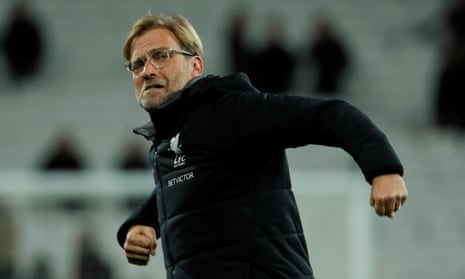Jürgen Klopp can occasionally not answer the question posed to him, and he was at it again after Liverpool’s 4-1 victory against West Ham United. Asked by a reporter to assess the contributions of Sadio Mané and Mohamed Salah, both of whom were excellent on a chilly evening in east London, Klopp decided instead to tell “the story of the game”, a blow‑by‑blow account of proceedings that lasted for four minutes.
It was a somewhat rambling response but, as is often the case with Klopp, also illuminating, and in this instance no more so than when the German spoke about Liverpool’s tactical plan for this fixture. “We changed the system,” he said. “The 4-4-2, which looked from the beginning a very offensive line-up, we had a different idea, we wanted to defend deeper, more compact.”
The explanation caught the attention not only because of the insight it offered but also because it pointed towards a potentially significant evolution in Liverpool’s development. Here was a new system deployed with the intent of making the team hard to break down – “defend deeper”, “compact”; words you do not often hear from a manager renowned for setting up his side to be on the front foot from the outset.
That has sometimes been Liverpool’s undoing under Klopp, seen most obviously in their recent defeat to Tottenham Hotspur, but here there was no chance of a repeat – partly due to the opposition being glaringly inferior but also because of Liverpool’s out-of-possession shape; two good old-fashioned banks of four, close together, cautious. Compact.
When Liverpool then pressed and countered, it was not only fast but also imaginative. Their shape went to a 4-2-4 in a blink of an eye, even sometimes a 2-4-4 with the full-backs, Joe Gomez and Alberto Moreno, lined up alongside the two central midfielders, Georginio Wijnaldum and Emre Can, as Liverpool’s front four of Mané, Roberto Firmino, Salah and Alex Oxlade-Chamberlain went for the kill, often rotating positions as they did so. During the first half in particular, West Ham were left confused and overrun in a manner that bore the hallmarks of Borussia Dortmund at their peak under Klopp.
It would be foolish to get carried away – this Liverpool side are not yet that Dortmund side and West Ham really were poor, delivering the type of display that makes it impossible to see Slaven Bilic continuing as manager. Nevertheless, Liverpool’s approach was striking and came at a notable time.
For it was exactly 12 months ago – Sunday 6 November 2016, to be precise – that they last topped the Premier League, having beaten Watford 6-1 at Anfield.
That was meant to mark lift-off for Klopp’s team but instead they slipped to second after their next fixture and have not returned to the summit since, with this campaign marked by the type of results and displays that suggest the team are going backwards under the man they hired 25 months ago.
The statistics bear that out. After the Watford game, which was their 11th of the 2016-17 season, Liverpool had 26 points, had scored 30 goals and conceded 14. At the same stage of this campaign they have 19 points, have scored 21 goals and conceded 17. According to Opta, they are also down in other areas, including possession (59.5% this season compared to 61.2% last), tackles success rate (18.1% compared to 19.1%), and big-chance conversion (46.7% compared to 60.7%).
And 12 months on from being leaders, Liverpool are sixth and 12 points behind the pace-setters, Manchester City. That already looks an insurmountable gap for a club craving a first championship since 1990.
Hence scepticism regarding the job Klopp is doing, yet given the way City have begun it is unlikely any side will stop them claiming the title. Also, it should be remembered Klopp is navigating his side through a Champions League as well as domestic programme this season, and sitting top of Group E with eight points after four fixtures, Liverpool look well placed to progress to the knockout stages.
Then there is the team. Deficiencies remain, and in that regard the failure to acquire another centre-back during the summer remains naive bordering on negligent. But overall since Klopp arrived, Liverpool have purchased well and in Salah have arguably the signing of the season. The Egyptian has not only provided pace and energy since arriving from Roma for £36.9m but also goals, with the two he got at West Ham taking his tally to 12 in 17 appearances. This is a winger, remember.
Mané, who assisted Salah’s two goals, with Joël Matip and Oxlade-Chamberlain also getting on the scoresheet, looks up to speed after his earlier than expected return from injury and with Philippe Coutinho and Adam Lallana expected to return after the international break, Liverpool will only become more dangerous going forward. From a defensive point of view, it should also be noted that this is a team that, relatively, do not concede many chances.
So it is not all bad, with the tactics deployed by Klopp on Saturday hinting at the next stage of a plan being put in place. Liverpool may not be where they want to be, but neither are they necessarily too far off.

Comments (…)
Sign in or create your Guardian account to join the discussion